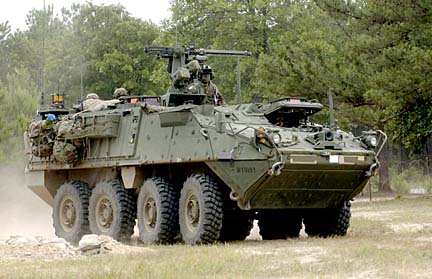
U.S. ARMY PHOTO
Technical problems dog the deployment of a Stryker brigade to Hawaii, but U.S. Sen. Daniel Inouye says they are "workable."
Stryker decision could
come this month
Whether the 25th Infantry Division (Light) gets the latest mobile combat vehicle -- the 19-ton, eight-wheeled light armored Stryker -- could be decided sometime this summer, possibly as early as this month.
U.S. Sen. Daniel Inouye, a senior member of the Senate Appropriations Committee, told reporters late last week: "If I were a betting man, I would easily say don't worry. We'll get it."
The Hawaii Democrat said there were some "technical" problems that still need to be ironed out before the official announcement can be made. "But they are workable," Inouye said.
Those issues focus on training areas needed by the Air Force's C-17 cargo jets, which will be used to transport the combat vehicles, Inouye said. This involved use of the runways at the Navy's Pacific Missile Range on Kauai.
The Stryker, named after two Medal of Honor recipients, is the brainchild and legacy of retired Army Chief of Staff Gen. Eric "Ric" Shinseki from Kauai, once the Army's highest-ranking officer. The Strykers, much lighter than the 67-ton M-1A1 Abrams tanks, were conceived to be easily deployed. It is the first new Army vehicle to enter service since the Abrams tank in the 1980s.
However, late last year, Defense Secretary Donald Rumsfeld postponed until this summer the final decision on whether the two last Stryker brigades would be assigned to Schofield Barracks and the Pennsylvania Army National Guard.
This was after tests on the first two Stryker brigades at Fort Lewis, south of Tacoma, Wash., raised questions about its capabilities. However, at the same time, the Pentagon approved two other brigades and assigned them to Fort Polk, La., and Fort Richardson in Alaska.
Each combat team comes with more than 350 Strykers, vehicles that can be outfitted in 10 different ways, with everything from a 105 mm cannon for a mobile gun system to a completely wired command center. The units with 3,614 soldiers are designed to be deployed anywhere in the world within 96 hours.
Last year, Rumsfeld said the Army would have until this summer to justify funding the Hawaii and Pennsylvania units.
At a Mililani Rotary Club luncheon June 18, Inouye pointed to large sums of money in the military construction budget, which will go into effect Oct. 1, earmarked for Hawaii to prepare for the transformation of the 25th Infantry Division's 2nd Brigade to the more lethal and mobile Stryker unit.
Later in the month, Inouye said four of the 21 military construction projects for Hawaii at Schofield Barracks next year are to build new facilities, add more soldiers and buy more training area in anticipation of the conversion to the Stryker brigade.
The Army here will receive $71.8 million in Stryker-related funds: $33 million to build facilities to support additional training needs, $18 million for information systems, $19.4 million to acquire training areas at Schofield Barracks' South Range, $1.4 million for land easement in Helemano.
Eventually, the Pentagon envisions spending more than $693 million in 32 Army construction projects at Schofield Barracks and the Big Island's Pohakuloa Training Area to accommodate the new unit. By 2004, Schofield's Stryker brigade would be beefed up with nearly 500 additional soldiers and 350 new combat vehicles.
Inouye said the $9.2 billion military construction appropriations bill expected to clear Congress by the end of this summer also allocates nearly $78.3 million for seven projects at Hickam Air Force Base that would pay for the formation of a new transport squadron with eight new C-17 cargo jets.
The unit would be composed of active-duty Air Force and Hawaii Air National Guard personnel whose mission would primarily be to support the Stryker brigade.
Each of the six Stryker brigades will cost between $2 million and $3.4 million.
Capt. Kathy Turner, 25th Division spokeswoman, said the environmental impact statement justifying the conversion of the 25th Division's 2nd Brigade into a Stryker unit, which was scheduled to be released last month, is still being reviewed by the Pentagon.
As part of the process, the Army is negotiating with Campbell Estate to acquire 71 acres adjacent to its Kahuku Training Area on Windward Oahu. The price tag on the land, which once was a windmill farm, is $1 million. That would be in addition to the 8,214 acres the Army bought from Campbell Estate in 1999 for $23.5 million.
The Army is also seeking the purchase or lease of an additional 1,500 to 2,100 acres from Campbell Estate in Kunia to build a new firing range and a motor pool and equipment storage and maintenance facilities large enough to support a brigade-size unit in South Range.
